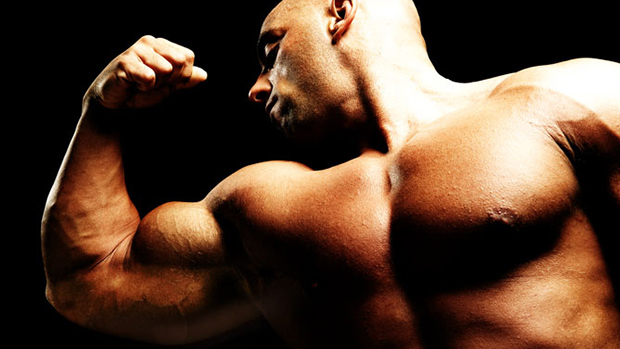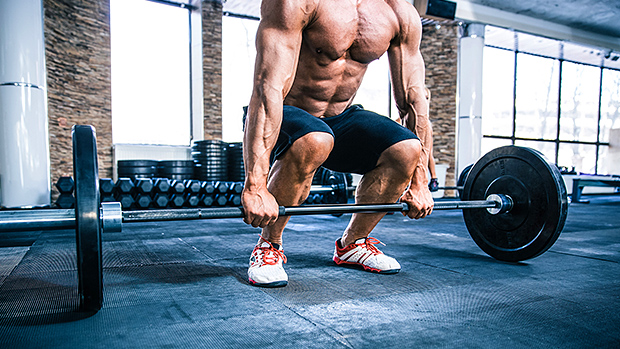The great majority of men in the iron game, probably 80%, started training because they wanted big arms. The other 20% are, of course, liars. Even if having great guns isn't an aspiring bodybuilder's top priority, I'm willing to bet it's way the hell up there.
It's easy to see why arms are so popular: most people equate bulging, muscular arms with great power, and who doesn't want to look powerful? Plus, your arms are the easiest body part to show off. Unlike your pecs and glutes, which (one hopes) are usually covered with clothing in public, your arms can be displayed naked and proud almost all the time. Especially in the gym.

It's no surprise, then, that I get a ton of requests for an arm specialization program. I'm always a bit reluctant to design this kind of program, because building big legs, a wide, thick back, and a powerful chest and shoulders are really what you should be specializing in. But hey, who am I to judge? You asked for it, you got it. If your biggest dream is building an impressive pair of guns, then this program might be just what you've been looking for.
First off, let's review the rules of specialization training:
- Train no more than 4-5 total times per week.
- Reduce the amount of work for the non-target groups to maintenance levels.
- Split the volume for the target muscle group(s) into 2-3 weekly sessions.
- Don't specialize on the same muscle group(s) for more than 4-6 weeks.
- Perform different types of workouts during your weekly target sessions.
- To maximize your results, increase your Surge intake on the target days (add one serving).
- The most growth will occur afterthe completion of the specialization phase, not during the phase.
Next, let's take a closer look at the muscles of the upper arm, particularly the ones that will determine overall size. Understanding their individual functions will also help us select the exercises and training methods that will give us the best results.



These flex the upper arm. Most people associate elbow flexion solely with the biceps, but the brachialis and brachioradialis muscles also play an important role. The biceps are also used to flex the shoulder (imagine a front raise), along with the coracobrachialis, which lies just under the biceps and contributes somewhat to the size of your arm.
Any curling exercise will hit all of these muscles to some degree, but you can place more stress on specific muscles by varying the way you perform each exercise. Rep speed, hand position, and grip width all have an effect on muscle recruitment.

In the table above, note that relatively fast movements (concentric 1-2 seconds or less, negative 2-3 seconds) will involve primarily the biceps, while slower movements (concentric over 2 seconds, negative 4-5 seconds or more) will rely more on the brachialis. A supinated (palms up) grip makes the biceps do most of the work, while a pronated (reverse) grip shifts the stress to the brachioradialis. A semi-supinated (hammer) grip is best for really hitting the brachialis, and it works the brachioradialis as well.

In the diagram above, notice how the width of your grip (actually the difference in width between your hands and elbows) affects which portion of the biceps will receive the most stimulation. A wide grip (wider than elbows) hits the short (inner) head, while a narrow grip emphasizes the long (outer) head.
Remember that the coracobrachialis assists the biceps in flexing the shoulder. By simply raising your elbows once they are fully flexed, you can emphasize the coracobrachialis while placing some extra stress on the inner head of the biceps. So for full upper-arm development, be sure to include some exercises where you raise your elbows at the top of each rep.

The triceps brachii is the major muscle involved in elbow extension (although the anaconeus muscle also plays a minor role). The triceps is composed of three heads: the lateral (outer) head, the medial (inner) head, and the long head, which runs above the medial head and is parallel to the lateral head. The long head of the triceps also comes into play when extending and adducting the shoulder, such as when doing pullovers or lat pulldowns.
Because the triceps has three distinct heads, you can increase the tension on a specific portion of the muscle by varying the way you perform an exercise, just as you can with the biceps. An exercise done with the elbows farther apart than the hands, for example, stresses the lateral head of the triceps, especially if the shoulders are internally rotated (elbows out). Conversely, if the hands are farther apart than the elbows, more stress is placed on the long and medial heads.
A supinated grip (palms up) also emphasizes the long and medial heads, and you can place even more tension on the long head by flexing the shoulders, as in overhead cable triceps extensions. Triceps extensions with the arms down (elbows pointing toward the ground) will put more emphasis on the medial head.


I used triceps extensions to illustrate how grip spacing and arm position can affect muscle recruitment, but the same principles apply to the close-grip pressing exercises:
- Close-grip presses with elbows out emphasize the lateral head
- Close-grip presses with elbows in emphasize the medial and long heads
- Decline close-grip presses (and dips) emphasize the medial head
- Incline close-grip presses emphasize the long head
Now that we're more familiar with the muscles of the arm and their various functions, let's go build some big guns!
Because we want to train the targeted muscle group three times during the week, we'll be training a total of five times per week. The weekly breakdown is as follows:
- Monday: Triceps (strength)/ Biceps (outer head)
- Tuesday: Quads/Hams/Calves
- Wednesday: Triceps (lateral head)/Biceps (inner head)
- Thursday: OFF
- Friday: Chest/Back/Shoulders
- Saturday: Triceps (long and medial heads)/Brachialis
- Sunday: OFF
Monday: Triceps (strength)/ Biceps (outer head)
A1. Close-Grip Bench Press

Grip the bar just narrower than shoulder width. Keep your elbows tucked in throughout the movement.
- Sets: 5
- Reps: 4 to 6
- Special Technique: alternate A1 and A2, with 45-second interval between sets (1 x A1, rest, 1 x A2, rest, 1 x A1, rest etc.)
A2. Standing Barbell Curl
Hold the bar in a narrow grip (hands inside wrists), with elbows out.
- Sets: 5
- Reps: 4 to 6
B. Partial Close-Grip Bench Press (Rack Lockout)

Start the bar from the stops of a power rack, with the height set so the bar is several inches above your chest (just above your weak point). Begin each rep from this position.
- Sets: 3
- Reps: 4 to 6
- Rest Intervals: 90 seconds
- Special Technique: partial reps, overload
C1. Barbell Concentration Curl

Hold the bar in a close grip, with elbows wide. As you bring the weight up, force your elbows out even more by pushing against your knees.
- Sets: 3
- Reps: 8 to 10
- Special Technique: superset C1 and C2 (no rest between C1 and C2), rest 90 seconds after C2.
C2. Single Dumbbell Static Hold
Support a vertical dumbbell with both hands under the top weight section and your elbows bent at 90 degrees.
- Sets: 3
- Static Hold: 20-40 seconds
Wednesday: Triceps (lateral head)/Biceps (inner head)
A1. Close-Grip Bench Press
Use a slightly narrower grip than you used on Monday, with your elbows flared out at 45 degrees.
- Sets: 4
- Reps: 6 to 8
- Special Technique: alternate A1 and A2, with 45-second interval between sets, as on Monday.
A2. Preacher Curl

Your grip should be wider than your elbows. The closer your elbows, the more effective this exercise will be.
- Sets: 4
- Reps: 6-8
B1. Tate Press (Pronated Grip Triceps Extension)

Starting position is the same as the end of a dumbbell press: elbows out, thumbs facing each other. Lower the dumbbells to your chest by flexing only your elbows. End with elbows pointing out and fists facing each other.
- Sets: 3
- Reps: 8 to 10
- Special Technique: superset B1 and B2
B2. Rope Triceps Extension
As you extend your arms, bring hands apart laterally as far as possible.
- Sets: 3
- Reps: 8 to 10
C1. Standing Barbell Curl
Use a wide grip, elbows close to your body.
- Sets: 3
- Reps: 8 to 10
C2. Incline Dumbbell Curl

Begin with a hammer grip, supinating your hands as you curl the dumbbells up. Fully stretch your biceps at the bottom of each rep. When your elbows are fully flexed, raise them 3 to 4 inches.
- Sets: 3
- Reps: 10 to 12
Saturday: Triceps (long and medial heads)/Brachialis
A1. Close-Grip Bench Press with Reverse Grip

Take the bar in a reverse grip just wider than shoulder width. Keep your elbows tucked in throughout the movement.
- Sets: 4
- Reps: 6 to 8
A2. Dumbbell Hammer Curl
- Sets: 4
- Reps: 6 to 8
- Special Technique: superset A1 and A2 (no rest between A1 and A2), rest 90 seconds after A2.
B1. Decline Nosebreaker with Reverse Grip

- Sets: 3
- Reps: 8-10
- Special Technique: superset B1 and B2
B2. Overhead Dumbbell Triceps Extensions

Use a single dumbbell held in both hands.
- Sets: 3
- Reps: 12-15
C1. Standing Barbell Curl with Reverse Grip
Take 3 seconds for the concentric movement, 5 seconds for the negative.
- Sets: 3
- Reps: 6 to 8
- Special Technique: superset C1 and C2
C2. Zottman Curl
Curl a pair of dumbbells, supinating your hands (palms up) on the concentric movement and pronating them (palms down) on the negative.
- Sets: 3
- Reps: 10 to 12
If you're sharp, you'll have noticed that this specialization program doesn't use the classic HSS-100 template. Why? Because it makes more sense to specialize on both biceps and triceps in any training phase. These muscles represent such a small percentage of your total muscle mass, it would be pretty foolish to specialize only one or the other. You really can't train two muscles in the same session using the full HSS-100 template – it would be too much. This program follows the basic principles, but in a condensed form.
This program stimulates your upper arms four times a week (three times directly and once indirectly), putting them in a state of "overreaching" (short-term overtraining). This will lead to a rebound effect when you return to your regular training program, and you will see the greatest growth in the two weeks following this specialization phase.
For even greater gains, I would even recommend drastically cutting back on your arm exercises during this 2-week post-specialization period, training arms only once a week, 6 sets total for biceps and 6 or fewer sets total for triceps.
Finally, remember that during this kind of blitz routine, you need to adjust your nutritional strategy. Increase your caloric intake on your three arm spec days each week, overload on the BCAAs, and treat yourself to a double dose of Mag-10®.
Welcome to the Gun Club!





